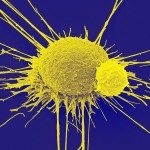Lien vers Pubmed [PMID] – 16140393
Immunol. Lett. 2006 Jan;102(1):1-9
Notch signaling is a highly conserved pathway involved in cell fate choice during development with Delta and Jagged constituting the two evolutionary conserved families of Notch ligands. These ligands are transmembrane proteins with conserved biochemical structure that share their receptors and signal through a common mechanism. Upon ligand binding Notch receptors are proteoliticaly cleaved, the intracellular domain of Notch (NICD) is released and translocated to the nucleus, where it activates target genes. In mammals, four receptors and five ligands have been described. Delta-1, Delta-3 and Delta-4 are homologues to Drosophila Delta and Jagged-1 and Jagged-2 to Drosophila Serrate. Despite strong domain homology, there is growing evidence that signals transmitted through Delta or Jagged ligands can differentially affect the target cell. At least during embryonic development, Notch receptors and Notch ligands functions cannot be compensated by other members. Knock-out mice for Notch-1, Notch-2, Delta-1 and Jagged-1 are embryonic lethal . Similarly, mice heterozygous for Delta-4 inactivation also die before birth . Invalidation of Jagged-2 results in defaults in thymus morphology and gammadelta development . Altogether, these data suggest that each Notch member can exert unique specific effects. In this review, we will thus focus on recent data about differential effects of Notch ligands on T cell development and differentiation. In light of recent biochemical and molecular advances on Notch-signaling pathway, we will examine how specific effects can be mediated by a given ligand.

